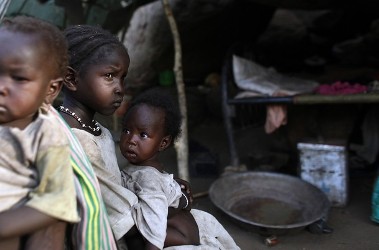South Kordofan villages targeted in SAF bomb attack: SPLM-N
October 22, 2013 (KHARTOUM) – A Sudan Armed Forces (SAF) Antonov plane has attacked South Kordofan’s Umdorain county, causing civilian casualties and destroying homes and farmland, the rebel Sudan People’s Liberation Movement-North (SPLM-N) said in a statement.

Five civilians were wounded in the attack, including an 85-year-old woman and a 75-year-old man.
One home was destroyed and a donkey belonging to the same family was also killed.
In a separate attack on the same day, four bombs were dropped on Achron village, causing widespread panic amongsst civilians in the area and severe damage to farmland.
The attack comes as a monitoring group said on Tuesday that there is evidence to suggest the Sudanese army may be readying its forces for a fresh military campaign in Kordofan.
The Satellite Sentinel Project (SSP), which Hollywood actor George Clooney founded in 2010 along with Enough Project co-founder John Prendergast, said satellite imagery showed unusually high levels of activity at several SAF military installations in North and South Kordofan states, which could indicate planned deployments toward several locations, including the highly-contested Abyei area.
SSP said that one set of imagery shows SAF air power in El Obeid Air Base in North Kordofan being beefed up with attack helicopters, a close-air-support aircraft and a transport aircraft.
In its August human rights update, the Sudan Consortium said civilians in South Kordofan continue to suffer indiscriminate bomb attacks by the Sudanese military, which the group says is contributing factor behind ongoing food insecurity in the region.
The group has accused the Sudanese government of deliberately targeting civilians, as well as fertile agricultural land during harvest season.
“The timing of these bombing attacks in both 2012 and 2013 to coincide with the agricultural cycle appears to indicate a deliberate and ongoing intention on behalf of the Sudanese government to disrupt the planting and harvesting of food crops”, the report said.
“In addition to the destruction of crops, the attacks have also killed large numbers of livestock further limiting the capacity of the civilian population to feed and sustain itself”, it adds.
Advocacy groups have accused the Sudanese government of applying a scorched earth policy as a military strategy.
Earlier this year, a top UN official warned the UN Security Council (UNSC) that hundreds of thousands of people in South Kordofan were living in desperate circumstances, surviving on roots and leaves and hiding in caves to avoid aerial bombardments.
“This is 2013 and to think that tens of thousands, hundreds of thousands of people are living in such desperate and deplorable circumstances and we can’t get in to help them”, UN humanitarian operations director John Ging told reporters following the closed door meeting.
Both the Sudanese government and rebels continue to block humanitarian access to international aid workers.
The USAID-funded Famine Early Warning Systems Network (FEWS NET) reports that internally displaced persons (IDPs) in the SPLM-N-controlled areas of South Kordofan are facing emergency and crisis levels (IPC Phase 3 and 4) of food insecurity.
In its latest humanitarian bulletin on Sudan, the UN Office for the Coordination of Humanitarian Affairs (OCHA) said aid agencies had reported that more than 2,600 Sudanese refugees had fled rebel-held areas in South Kordofan amid ongoing conflict and worsening food shortages in the region.
South Kordofan and neighbouring Blue Nile state has been the scene of violent conflict between the SPLM-N and SAF since 2011.
The Sudanese government have consistently accused South Sudan of backing the rebels – which fought alongside the South during its struggle for independence from the north – although Juba denies the claims.
Long-delayed negotiations between Khartoum and the SPLM-N on ending the military conflict in the two areas stalled in April without any clear resolution.
According to the UN Refugee Agency (UNHCR), some 197,000 Sudanese refugees from South Kordofan and Blue Nile states have sought shelter in camps in South Sudan’s Unity and Upper Nile states since the conflict began.
In the same period, an estimated 32,000 refugees, mainly from Blue Nile, have fled to the Assosa region of Ethiopia.
(ST)
Parts of this article were based on a report by the Sudan Sentinel Project: Human Security Warning: Sudan Army Poised for Offensive in South Kordofan or Abyei
October 22, 2013. On October 24 the organisation contacted Sudan Tribune to say:
An earlier version of this report attributed aircraft participating in a UNISFA troop rotation at Kadugli Air Base to the Sudan Armed Forces. Since the signature visual identifiers of SAF helicopters match those of United Nations aircraft, imagery analysts find it difficult to distinguish between the two.
